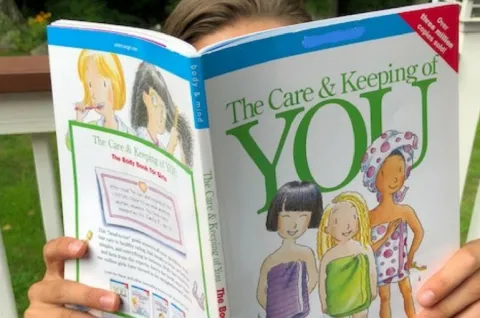Your Daughter Got Her Period; Now What?

Perhaps nothing signals that your little girl is growing up like the start of her period. Since so many of my patients ask me how to discuss this topic with their daughters and what to expect, here are a few pointers:
Start the Discussion Early
Don't wait until your daughter actually starts her period (which, on average, occurs around age 12 or 13) to start talking about menstruation. I generally recommend that you begin broaching the subject as early as age 8. Yes, some girls start sexual development that young!
Instead of leading off with menstruation (which is likely to elicit "Eww!" from most 8-year-olds), start talking about puberty in general, putting it in the context of a natural process, perhaps saying that someday their body will change and be more like mommy's, with breasts and hair in certain areas.
Remember, this isn't a one-and-done, you want to begin an ongoing dialogue so your daughter feels comfortable discussing this with you, and coming to you if she has questions. And when she actually gets her period, you've already had a series of talks about normal development, so she's not totally unprepared.
It can help to have these talks when you're doing something else together; baking cookies, hiking, or even driving, so you don't have to maintain eye contact, especially if your daughter feels embarrassed. Or if you're grocery shopping together, you can pick up a feminine hygiene product and use that as a conversation starter.
When Will Your Daughter Get Her First Period?
Before your daughter gets her first period, you'll start to notice other changes in her body. Most girls start developing breast buds between ages 9 and 10; this usually precedes her first period by two to three years.
What Is a Normal Menstrual Cycle?
When your daughter first starts her period, it's important to be able to differentiate between normal and abnormal menses. In general:
- The interval between periods can range from 21 to 45 days, with an average of 32 days.
- Each period can last from two to seven days.
- Flow ranges from 30 to 80 milliliters a day, which translates into three to six pads or tampons per day.
- About three years after the first period (on average), a girl's period normalizes and becomes more like an adult's with a cycle of 21 to 35 days, and duration of four to six days.
If your daughter has her own smartphone, you may want to get her a special teen period tracker app to help her keep track of her menstrual cycle.
Handling Premenstrual and Menstrual Symptoms
Unpleasant symptoms like cramps, bloating, weight fluctuation and mood swings often accompany menstruation. Here are some tips on how to explain them to your daughter and help her cope:
- Bloating, weight gain and mood swings can occur five to seven days before menstruation. They're tied to cyclical fluctuations in sex hormones (estrogen, progesterone) and serotonin (a chemical that nerve cells produce that can affect thoughts and emotions). The good news is that these symptoms usually go away once her period starts.
- Cramping is a physiological mechanism to expel the blood from the uterus. Ibuprofen or something similar can help relieve the discomfort. A heating pad can also help.
- If severe mood swings are affecting your daughter's daily activities, low-dose oral contraceptives can even things out.
- To minimize premenstrual symptoms overall, make sure your daughter eats a balanced diet with plenty of complex carbohydrates, fruits, and vegetables; avoids sugar, salt, and caffeine; exercises regularly; and practices good sleep habits.
When To See a Doctor
You should consult a physician if your daughter:
- Goes more than 90 days between periods
- Has breakthrough bleeding in between periods
- Has cycles shorter than 21 days
- Experiences unusually heavy flow (must change pads/tampons every one to two hours)
- Has severe premenstrual symptoms that interfere with school, sports or other regular activities
Pads or Tampons?
For girls who have just started menstruating, pads tend to be easier to handle and don't feel as "invasive" as a tampon. But any girl who has her period can use a tampon and, if your daughter is active in sports, tampons may be a good option. And rest assured, tampons won't cause your daughter to lose her virginity!
Finally, remember that menstruation is a perfectly natural, normal part of development. If you're comfortable and relaxed talking about it, chances are your daughter will be, too!
Guest Blogger: Lourdes Uy, MD, Obstetrician/Gynecologist at UMass Memorial Health - HealthAlliance-Clinton Hospital
Other related articles by:
menses | menstrual cycle | menstruation | Periods | puberty | sexual development | TeenNote: The content of this blog is for informational purposes only. It is not intended for use as diagnosis or treatment of a health problem or as a substitute for the professional consultation of a physician or qualified health care provider. If you have specific questions or concerns regarding a health or medical condition, contact your physician or a licensed health care professional.

